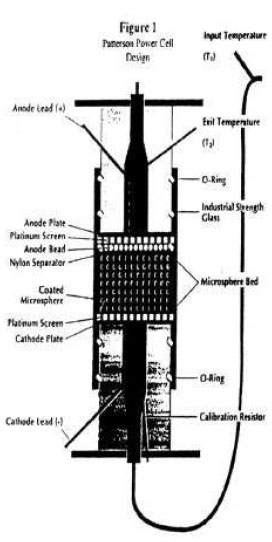CETI Patterson Power Cell

The CETI Patterson Power Cell is a patented invention of U.S. physicist James Patterson to generate heat based on an assumed cold fusion. The invention was met with occasional media interest in the United States, in chat shows from ABC, Nightlife, and "Good Morning America." A reception by scientific physics is not apparent and independent replications of the alleged effect are not known. In 1997, manufacturer CETI announced that Patterson-cells would go into mass production within 4 years to supply the general public. This has not occurred as of yet and so the concept is now just of historical interest as one of the few patented processes in the field of "cold fusion".
This invention received one of few patents granted instead of being denied because of the idea of "cold fusion". The United States patent office, however, does not check the feasibility of a described effect (see List of absurd patents, or the absurd Energy Cleaner by Crock successfully patended in the United States).
Manufacturers of the Patterson cell are Messrs "Clean Energy Technologies, Inc." (CETI) from Dallas, Texas.[1] The company earns its money selling so called "Rifex kits", experimental cells for interested people. Buyers receive a temporary permit from CETI to participate in the company's conferences and will receive newsletters. A similar kind of marketing was also implemented by the failed Irish company Steorn.
The CETI Patterson Cell
The reactor said to perform the alleged fusion processes is a non-conductive housing filled with thousands of small plastic beads coated with thin film layers of nickel and palladium. The great number of plastic beads aims to increase the reacting surface. The beads are surrounded by a solution of a conductive salt in water through which an electric current is being run. A fusion of hydrogen and deuterium nuclei is said to happen. But no fusion products or ionizing radiation have been proven.
With an input of 1.4 Watts electrical energy, the cell is claimed to yield a hundred or a thousand times that energy in the form of heating output. According to inventor Patterson, radioactive uranium isotopes which are present in the cell were transmuted to non-radioactive isotopes in an unknown way.
Patent
- US Patent US 5494559, James Patterson, "System for electrolysis". Granted on April 3, 1997.
Abstract:
"ABSTRACT: An electrolytic cell and system for electrolysizing and/or heating a liquid electrolyte containing water having a conductive salt in solution flowing through the cell. The electrolytic cell includes a non-conductive housing having an inlet and an outlet and spaced apart first and second conductive foraminous grids connected within the housing. A plurality of spaced beds of closely packed conductive microspheres are positioned end to end within the housing in electrical contact with the first grid adjacent the inlet. The individual microsphere beds are electrically isolated from one another in the absence of the liquid electrolyte. The microspheres are generally uniform in size and density and include a plated layer formed of metallic hydride which is readily combineable with hydrogen or an isotope of hydrogen with hydrazine to form a conductive, preferably flash coated metal layer. An electric power source in the system is operably connected across the first and second grids whereby electrical current flows between the grids within the liquid electrolyte."
Versions of this article in other languages
- Deutsch: CETI Patterson Power Cell
Literature
- Robert L. Park: Voodoo science: the road from foolishness to fraud. page 111
Weblinks
- US Patent 5494559
- article in the english wikipedia
- http://newenergytimes.com/v2/archives/fic/J/JNE1N3.PDF
References
- ↑ Clean Energies Technology, Inc. (CETI), WWW: http://www.cleanenergy.com/ceti, Phone: (214) 983-8340, Lincoln Center One, 5400 LBJ Freeway, Suite 950, Dallas, TX 75240